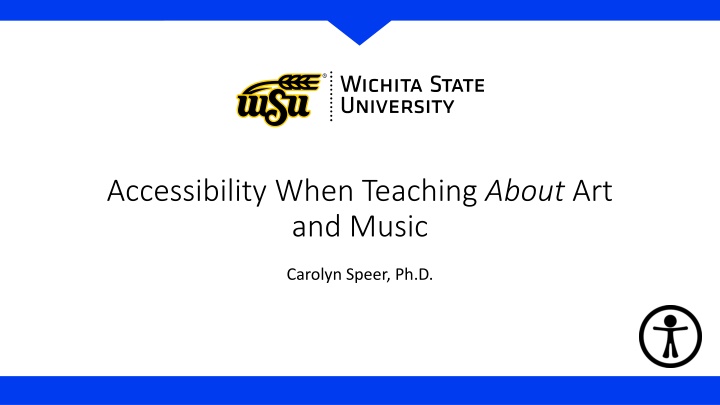
Accessibility in Art and Music Education
Explore the essential principles of accessibility in teaching art and music, distinguish between accessibility and accommodation, and learn universal design basics for an inclusive learning environment. Discover practical tips for creating accessible content and promoting equity for diverse learners.
Download Presentation

Please find below an Image/Link to download the presentation.
The content on the website is provided AS IS for your information and personal use only. It may not be sold, licensed, or shared on other websites without obtaining consent from the author. If you encounter any issues during the download, it is possible that the publisher has removed the file from their server.
You are allowed to download the files provided on this website for personal or commercial use, subject to the condition that they are used lawfully. All files are the property of their respective owners.
The content on the website is provided AS IS for your information and personal use only. It may not be sold, licensed, or shared on other websites without obtaining consent from the author.
E N D
Presentation Transcript
Accessibility When Teaching About Art and Music Carolyn Speer, Ph.D.
Agenda Accessibility is not accommodation Accessibility basics Universal design basics When more is more Writing alt txt for images Questions
Its not a catastrophe! Accessibility: actions taken in advance to benefit populations of people Accommodations: specific tailoring for individuals Accessibility is NOT the same thing as accommodations Instructors are obligated to facilitate accommodations deemed necessary and appropriate by the college s Disability office Good accessibility habits make the accommodations process easier
Accessibility basics Remediating existing documents is hard Start by using your tools in Microsoft products Make changes through editing styles/templates Streamline: avoid unnecessary visual complexity Beware of color alone carrying information Get any necessary training from KSARN.org
Design learning for the max Accessibility asks us to re-think our methods Start with the goals of your course Think about ways to as many people as possible to those goals Does your content systematically exclude people? If so, is that necessary? If not, then how can you start to address those issues? Taking a universal design perspective helps frame this process
Universal design basics Equitable use: design is usable by people with diverse abilities. Flexible: design accommodates a wide range of performances and abilities. Simple and intuitive: design is understandable regardless of experience, language, knowledge, and mental concentration. Perceptible information: design communicates information regardless of user s sensory abilities. Tolerance for error: design minimizes hazards and adverse consequences of unintended or accidental actions. Low physical effort: design can be used effectively and comfortably with minimum of fatigue. Size and space for approach and use: design has room for ease of physical maneuvering regardless of user s body size, posture, or mobility.
When more is more Focus on communicating on two cognitive channels Have an art example? Can you add a music example? Have a literature example? Can you add an art example? Present digital information in more than one file type PDF are great in Blackboard, but might not work well with screen readers Document files are often better with screen readers, but require downloading, which might not be good for many students Consider offering more than one project type or other ways students can communicate what they have learned
Writing alt text for educational images Original: gray cat sitting on lying brown dog Illustrates a poem? Animal advocacy? Travel? Photography class? Biology? Other interpretations? Photo by Ancaro Project on Unsplash
